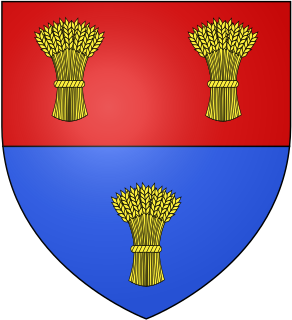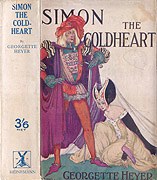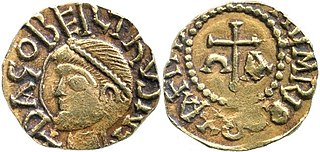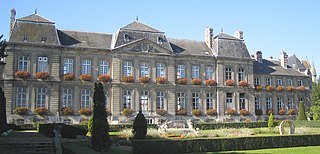
Saint Anthony or Antony, was a Christian monk from Egypt, revered since his death as a saint. He is distinguished from other saints named Anthony such as Anthony of Padua, by various epithets of his own: Anthony the Great, Anthony of Egypt, Antony the Abbot,Anthony of the Desert,Anthony the Anchorite, and Anthony of Thebes. For his importance among the Desert Fathers and to all later Christian monasticism, he is also known as the Father of All Monks. His feast day is celebrated on 17 January among the Orthodox and Roman Catholic churches and on Tobi 22 in the Coptic calendar used by the Coptic Church.
The 640s decade ran from January 1, 640, to December 31, 649.
Year 640 (DCXL) was a leap year starting on Saturday of the Julian calendar. The denomination 640 for this year has been used since the early medieval period, when the Anno Domini calendar era became the prevalent method in Europe for naming years.

William de Braose,, 4th Lord of Bramber, court favourite of King John of England, at the peak of his power, was also Lord of Gower, Abergavenny, Brecknock, Builth, Radnor, Kington, Limerick, Glamorgan, Skenfrith, Briouze in Normandy, Grosmont, and White Castle.

The Little Mermaid is a fairy tale written by the Danish author Hans Christian Andersen. The story follows the journey of a young mermaid who is willing to give up her life in the sea and her identity as a mermaid to gain a human soul. The tale was first published in 1837 as part of a collection of fairy tales for children. The original story has been a subject of multiple analyses by scholars such as Jacob Bøggild and Pernille Heegaard as well as the folklorist Maria Tatar. These analyses cover various aspects of the story from interpreting the themes to discussing why Andersen chose to write a tragic story with a happy ending. It has been adapted to various media, including musical theatre, anime and a Disney animated film. There is also a statue portraying the mermaid in Copenhagen, Denmark, where the story was written and first published.

Joan, often called Joan of Constantinople, ruled as Countess of Flanders and Hainaut from 1205 until her death. She was the elder daughter of Baldwin IX, Count of Flanders and Hainaut, and Marie of Champagne.

Zadig ou la Destinée is a novella and work of philosophical fiction by the Enlightenment writer Voltaire. It tells the story of Zadig, a philosopher in ancient Babylonia. The author does not attempt any historical accuracy, and some of the problems Zadig faces are thinly disguised references to social and political problems of Voltaire's own day.

Ibong Adarna is a 16th-century Filipino epic poem about an eponymous magical bird. The title's longer form during the Spanish Era was "korido at Buhay na Pinagdaanan n͠g Tatlong Principeng Magkakapatid na anak ni Haring Fernando at ni Reyna Valeriana sa Kahariang Berbanya".

Life Is a Dream is a Spanish-language play by Pedro Calderón de la Barca. First published in 1635 during the Spanish Baroque period (NADV1), it is a philosophical allegory regarding the human situation and the mystery of life. The play has been described as "the supreme example of Spanish Golden Age drama". The story focuses on the fictional Segismundo, Prince of Poland, who has been imprisoned in a tower by his father, King Basilio, following a dire prophecy that the prince would bring disaster to the country and death to the King. Basilio briefly frees Segismundo, but when the prince goes on a rampage, the king imprisons him again, persuading him that it was all a dream.
Snow White is a major character in the comic book series Fables. Her character is based on two myths recorded by the Brothers Grimm, Snow-White and Rose-Red and the more famous Snow White and the Seven Dwarves.

The Adventures of Sinbad is a Canadian Action/Adventure Fantasy television series which aired from 1996 to 1998. It follows on the story from the pilot of the same name. It revolves around the series' protagonist, Sinbad. The series is a re-telling of the adventures of Sinbad from The Arabian Nights. Created by Ed Naha, it was filmed in southern Ontario, Canada and in Cape Town, South Africa. The tone of the series resembled its contemporaries Hercules: The Legendary Journeys and Xena: Warrior Princess.

To Light a Candle is the 2004 second fantasy novel of Mercedes Lackey and James Mallory's Obsidian Trilogy.

Simon the Coldheart is a novel by Georgette Heyer.
The Doomsday Scenario is the collective name of a series of Judge Dredd comic stories published in 2000 AD and the Judge Dredd Megazine in 1999. Written by John Wagner, it was the third such crossover story between those two publications, but was the first in which it was possible to read a complete and coherent tale by reading only those episodes which appeared in one comic or the other without having to buy both magazines. It was reprinted as two trade paperbacks, each collecting the episodes from one comic. When first published it was the longest Judge Dredd story arc ever told, at a total of 32 episodes and 279 pages, as well as several prequels and epilogues. The story tells of the Second Robot War in the year 2121, but its epilogues wrapped up two story arcs that had been developing for several years: former judge Galen DeMarco's unrequited love for Judge Dredd, and Dredd's bitter rivalry with Judge Edgar. The story is also notable for leading to the promotion of Judge Hershey, Dredd's sidekick and one of the strip's longest-running supporting characters, to the office of chief judge.

Balladyna is a tragedy written by Juliusz Słowacki in 1834 and published in 1839 in Paris. It is a notable work of Polish romanticism, focusing on the issues such as thirst for power and evolution of the criminal mind. The story revolves around the rise and fall of Balladyna, a fictional Slavic queen.
Empress Liu, formally Empress Shenminjing, was the second wife and only empress of Emperor Zhuangzong of Later Tang, the founding emperor of the Chinese Five Dynasties and Ten Kingdoms period state Later Tang. In traditional histories, she was regarded as a hoarder of wealth who, during her husband's reign, became extremely powerful, with her own orders carrying the same weight as his own. It was the killing of the major general Guo Chongtao by at her order in 926 that created a cascade of military rebellions that led to Emperor Zhuangzong's downfall and death; she was subsequently killed by his adoptive brother and successor Li Siyuan.
Émile Pierre Ratez was a French composer, administrator, and violist.

League of Gods is a 2016 Hong Kong-Chinese fantasy film directed by Koan Hui and Vernie Yeung, based on the novel Fengshen Yanyi by Xu Zhonglin and starring an ensemble cast of Jet Li, Tony Leung, Fan Bingbing, Louis Koo, Huang Xiaoming, Angelababy, Wen Zhang, and Jacky Heung. The film was released in China on 29 July 2016.
















